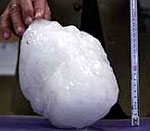Attack of the Giant Ice Balls!Dennis LoneyChemistry.org Jan. 31, 2007 |
Popular 
'Sniper Seen on Roof Overlooking Pro-Palestine Protest' at Indiana University

Mike Johnson Pushes Debunked Lie That Israeli Babies Were 'Cooked in Ovens' On October 7

Axios Poll: Majority of Americans Now Want Mass Deportations

Claim Jewish Student Was 'Stabbed In The Eye' by Pro-Palestine Protester Draws Mockery After Video Released

TikTok Will Shut Down Rather Than Sell to U.S. Investors If Ban Not Overturned in Courts
  In January 2000, Spain came under attack from an unknown assailant. Giant chunks of ice dropped from cloudless skies and crushed car hoods, punched through rooftops and windshields, and slammed into the shoulder of an elderly woman. In a 10-day period, 15 basketball-sized ice balls weighing up to 8 pounds pelted southern Spain. In January 2000, Spain came under attack from an unknown assailant. Giant chunks of ice dropped from cloudless skies and crushed car hoods, punched through rooftops and windshields, and slammed into the shoulder of an elderly woman. In a 10-day period, 15 basketball-sized ice balls weighing up to 8 pounds pelted southern Spain.At first, Spanish authorities deemed the mysterious mass the work of passing aircraft—likely frozen excrement from the lavatory or perhaps condensed ice sliding off the wing—and sent the offending ball to the laboratory to be examined. But then the ice balls kept falling, and new theories emerged: Perhaps it was something extraterrestrial like stray ice from a passing comet, or perhaps a byproduct of some strange new meteorological condition? Was it a hoax? Is it a hoax? Jesus Martinez-Frias, a senior scientist at the Center for Astrobiology in Madrid, raced all over Spain collecting the chunks of ice preserved by witnesses and brought them back to the lab for analysis. Martinez-Frias and his team found that the ice balls did not contain human excrement or the trademark blue disinfectant used in airplane toilets. They also discovered that the ice balls did not fall from an airplane’s fuselage because the sites did not correspond with known flight paths. They also found there was nothing extraterrestrial about them. Martinez-Frias and his co-workers discovered that the ice had the chemical signature of this world’s hailstones. Of course, after the story broke, a couple of merry pranksters made fraudulent ice balls—one out of salt, the other taken from a restaurant freezer—which were easily identifiable as imposters not only because of their chemical signature, but also because they lacked the trademark onionskin layering of hailstones. Most hailstones are the size of peas and weigh a fraction of an ounce; sometimes they reach the size of baseballs. The largest hailstone on record in the United States weighed in at 27 ounces—nowhere close to the 6 to 8 pound monsters that dropped on Spain. The really big hailstones usually accompany ferocious thunderstorms that produce tornados. Hailstones are formed by winds known as updrafts that blow upward in thunderstorms. The droplets of supercooled water—water that is at a temperature below freezing, but not yet ice—are carried upward where they hit ice crystals, freezing them instantly and causing the ice ball to grow. Hailstones cycle between the updraft to the top of the cloud, the descent along the outer edge of the cloud, and back up again. The hailstones grow with each revolution until they become too heavy for the updraft to lift anymore, and they fall out the bottom of the cloud. Which is why, what scientists are now calling megacryometeors are so puzzling. If megacryometeors really are big hailstones, the updrafts would have to be extremely strong. And you would expect that they would be accompanied by the storm of the century, but instead they have fallen from cloudless skies. Since the deluge of megacryometeors that rained on Spain in January 2000, the Martinez-Frias team has studied and followed this phenomenon; and they have found that this phenomenon isn’t unique to Spain. Argentina, Australia, Austria, Canada, Colombia, The Netherlands, New Zealand, and the United States have reported a megacryometeor event. In all, there have been more than 50 confirmations, and the researchers believe that is only a small fraction of the actual number. The ice balls are getting larger too: 25 and 35 pounders are frequently reported. Recently, Brazil reported a 440-pound behemoth. So what’s the deal—really big hail or something else? Global warming might be to blame: The researchers found a meteorological anomaly on the days preceding the megacryometeorological events; ozone levels were unusually low over southeastern Spain, which allowed more solar radiation to reach the troposphere, thereby cooling the lower stratosphere. Another meteorological team found that the lower stratosphere was unusually moist during the 10 days the ice balls fell. They speculated that the nuclei of the ice ball could have been lingering jet contrails that then descended through a nearly saturated atmosphere. There have been detractors. Some meteorologists and hail experts have denounced the theories posed by Martinez-Frias, stating that formation of hail without thick highly-visible clouds is an impossibility. However, in the summer of 2002, Martinez-Frias and fellow researchers proposed a novel mechanism for generating what one would constitute as hail on a clear day. Perhaps megacryometeors is the work of a master prankster; perhaps it’s the byproduct of global warming. I’m sure we’ll soon find out. After all, the sky is rising—say scientists in California. This article first appeared on March 1, 2004. |



